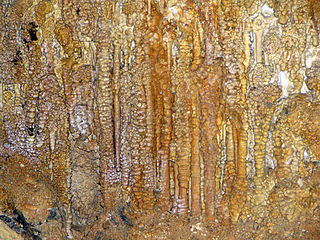 W
WCrkvine is a Neolithic locality and an archaeological site in the village of Stubline in the municipality of Obrenovac, which is part of the City of Belgrade, the capital of Serbia. The Neolithic settlement is dated to the 5th millennium BC and was part of the Vinča culture. The research of the site began in 1962 and the locality was declared a cultural monument in 2014.
 W
WThe Hadži-Prodan's Cave is an archaeological site of the Paleolithic period and a national natural monument, located in the village Raščići around 7 km (4.3 mi) from Ivanjica in western central Serbia. The rather narrow and high entrance with at an altitude of 630 m (2,070 ft) above sea level sits about 40 m (130 ft) above the Rašćanska river valley bed and is oriented towards the south. The 345 m (1,132 ft) long cave was formed during the Late Cretaceous in "thick-bedded to massive" Senonian limestone. Prehistoric pottery shards and Pleistocene faunal fossils had already been collected by Zoran Vučićević from Ivanjica. Animal fossils especially Cave bear and Iron Age artifact discoveries during an unrelated areal survey were reportedly made at the cave entrance and in the main cavern. The site is named in honor of Hadži-Prodan, a 19th century Serbian revolutionary.
 W
WLepenski Vir, located in Serbia, is an important archaeological site of the Mesolithic Iron Gates culture of the Balkans. The latest radiocarbon and AMS data suggests that the chronology of Lepenski Vir is compressed between 9500/7200–6000 BC. There is some disagreement about the early start of the settlement and culture of Lepenski Vir, but the latest data suggest 9500–7200 to be the start. The late Lepenski Vir architectural development was the development of the trapezoidal buildings and monumental sculpture. The Lepenski Vir site consists of one large settlement with around ten satellite villages. Numerous piscine sculptures and peculiar architecture have been found at the site.
 W
WNatural History Museum is a museum located in Belgrade, Serbia. It is one of the oldest specialized national institutions in Serbia. In fact, it is the only museum of this type in Serbia.
 W
WThe Pannonian Sea was a shallow ancient sea, where the Pannonian Basin in Central Europe is now. The Pannonian Sea existed during the Miocene and Pliocene epochs, when a 3–4 km (1.9–2.5 mi) depth of marine sediments were deposited in the Pannonian Basin.
 W
WRisovača Cave, is situated at the very entrance of the town of Aranđelovac in central Serbia around 17 m (56 ft) above the Kubršnica river valley. It is one of the most important archaeological sites of the Palaeolithic in Serbia besides the Gradac Cave near Kragujevac. Its discovery confirmed the assumed existence of the Paleolithic culture south of the Sava-Danube line and provided new information on the life of prehistoric humans in Europe.
 W
WSvilajnac is a town and municipality located in the Pomoravlje District of central Serbia. The population of the town is 9,131 inhabitants, while the municipality has 23,391 inhabitants.
 W
WSvilajnac is a town and municipality located in the Pomoravlje District of central Serbia. The population of the town is 9,131 inhabitants, while the municipality has 23,391 inhabitants.
 W
WVinča-Belo Brdo is an archaeological site in Vinča, a suburb of Belgrade, Serbia. The tell of Belo Brdo is almost entirely made up of the remains of human settlement, and was occupied several times from the Early Neolithic through to the Medieval period. The most substantial archaeological deposits are from the Neolithic-Eneolithic Vinča culture, of which Vinča-Belo Brdo is the type site.
 W
WJovan M. Žujović was a Serbian anthropologist, known as a pioneer in geology, paleontology and craniometry in Serbia.